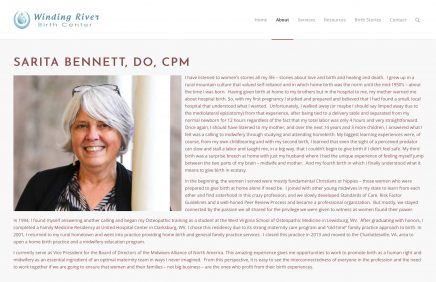
I’ve been writing about homebirth in one forum or another for more than 25 years. During that time I’ve seen some egregiously incompetent providers, but the case of Sarita Bennett, DO CPM, Secretary to the Board of Directors of the Midwives Alliance of North America may be the most chilling yet. Again and again and again Bennett “trusted birth” and again and again and again babies died at her hands. Now the state of Virginia has finally taken both her medical and midwifery licenses.
How many brain-injured and dead babies did it take?
Brain-injured Baby A:
Upon arrival to the hospital, the infant was noted to be in respiratory distress and hypothermic, with a heart rate of 70. He underwent extensive inpatient treatment and, upon discharge on or about October 1, 2016, his active problems included enteral feeding due to tachypnea, moderate hypoxic ischemic encephalopathy, respiratory distress, meconium aspiration syndrome, hyponatremia, and seizures.
Dead Baby B:
…[T]he infant was delivered at approximately 2:53 p.m. with nuchal cord wrapped five times around the neck. She was not breathing…
According to hospital records, upon arrival at the home, EMS performed CPR for approximately 20 minutes and then transported the infant to a local hospital emergency department, where she was intubated. She was then transferred to the NICU at another hospital. Despite intensive supportive measures, the. infant expired on January 22, 2017. The cause of death was documented as hypoxic ischemic injury secondary to nuchal cord.
Dead Baby C:
…[O]n or about September 30, 2017, Patient C went into labor. She arrived at the Birthing Center at 5:30 p.m. and the infant was delivered at 8:48 p.m… [T]he infant had no respiratory effort, did not respond to stimuli, and was limp, and that her extremities were blue… [Bennett’s] records indicate that she called EMS at 9:09 p.m., approximately 21 minutes after the infant was delivered (according to EMS records, the call was made at 9:12 p.m.).
According to hospital records, the infant suffered from severe hypoxic ischemic encephalopathy and expired after birth.
Dead Baby D:
[Bennett] returned to Patient D’s home at 10:00 p.m. on December 13, 2017 and found, as she recorded, “surprise! At introitis.” At 10:42 p.m., Respondent noted that the fetus was again in breech position, with the buttocks emerging. Despite this high-risk position, Respondent decided to proceed with the delivery at home…
[T]he infant was fully delivered at 11:22 p.m. on December 13, 2017. He was noted to be apneic, and Respondent performed positive pressure ventilation for approximately 30 minutes commencing at 11:22 p.m. In a statement to the DHP investigator, Respondent stated that she kept the umbilical cord unclamped in order to improve the infant’s oxygenation and blood supply; when the placenta was delivered, the infant’s heart beat stopped and Respondent started chest compressions and called EMS… Patient D and the infant arrived at the hospital emergency department … at 12:50 a.m. on December 14, 2017. The infant was pronounced deceased at 1:08 a.m. on December 14, 2017.
Brain-injured Baby E:
At approximately 11 :00 p.m., according to Respondents’ records, an ultrasound indicated that the infant was presenting in breech position. Respondent made the decision to continue with the labor at the birthing center rather than transferring Patient E’s care…
Patient E labored until 2:49 a.m. on October 27, 2019, when the infant’s buttocks emerged. The infant was fully delivered at 3 :00 a.m., 11 minutes after his buttocks had emerged. Respondent noted that he was not breathing and that she started chest compressions at 3:01 a.m. and provision of oxygen at 3:04 a.m. She documented that the infant was breathing at 3:25 a.m. Despite having to provide resuscitative care to the infant for 14 minutes, [Bennett] allowed the parents to return home with the infant.
[Bennett] provided post-natal care to Patient E’s infant for approximately 28 days. [She] failed to refer care of the infant to a pediatrician or pediatric neurologist when he displayed risks for developmental delays, including plagiocephaly; feeding concerns including no suck/swallow reflex, aspiration of milk, and spitting up; seizures; passing out; and increased muscle tone and agitation.
A brain MRI of the infant conducted at a hospital on November 26, 2019 revealed severe subacute hypoxic ischemic encephalopathy. In addition, hospital records indicate that the infant suffered other complications including bilateral hip dysplasia; poor state regulation; fibromatosis colli; and hearing deficiency.
Dead Baby F:
Patient F informed Respondent that four of her prior pregnancies had resulted in delivery by cesarean section … Patient F’s height was 5 feet, 2 inches, for a Body Mass Index (“BMI”) of 37.5.
…[O]n or about April 6, 2020, Patient F experienced spontaneous rupture of membranes at her home out of state. She and her husband drove to the Birthing Center and spent the night there… Patient F related that [Bennett] informed her that she was not satisfactorily dilated and that she would like to see Patient F in a hospital setting. However, Patient F related that Respondent failed to convey the urgency of the situation and even suggested that Patient F could return to a hospital in her home state… [Parents] left the Birthing Center and returned to their home.
At approximately 10:53 p.m. on April 7, 2020, the father called 911 from their home, reporting that the infant’s mn had anerged. Shortly !hereafter, Patient F arrived at the emergency department ofa ncarliy hospital via EMS. Hospital recolds indicate that upon arrival, the fetus was noted tobavc an ann hanging out of the cervix that was blue, 8Dd there was no disoemible fetal heart tone. The dead infant was delivered by emergency cesarean section at 11:39p.m. on April 7, 2020.
In a period of approximately 3 1/2 years, Sarita Bennett, DO LM presided over the deaths of FOUR babies and the brain injuries of TWO others.
How many dead babies does it take for a homebirth doctor to lose her license?
Too many!

